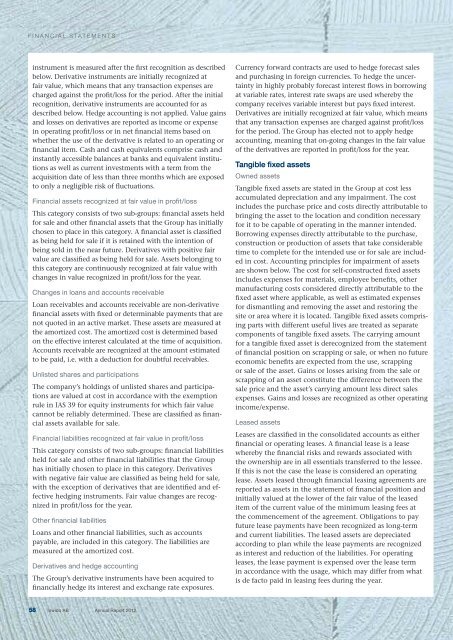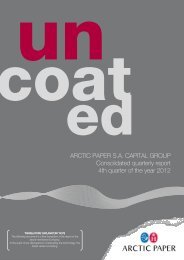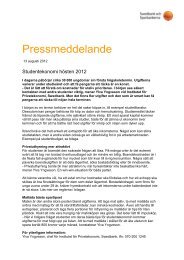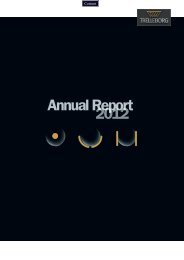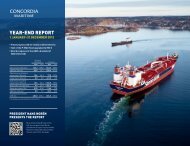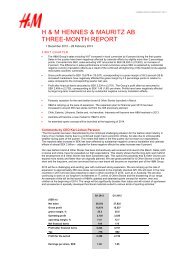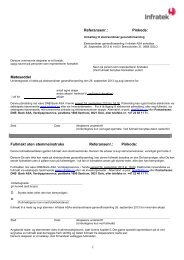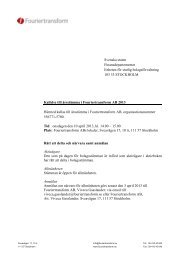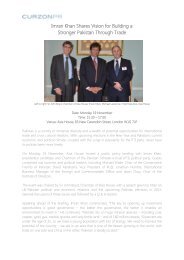Annual Report 2012 - Inwido
Annual Report 2012 - Inwido
Annual Report 2012 - Inwido
Create successful ePaper yourself
Turn your PDF publications into a flip-book with our unique Google optimized e-Paper software.
FINANCIAL STATEMENTS<br />
instrument is measured after the first recognition as described<br />
below. Derivative instruments are initially recognized at<br />
fair value, which means that any transaction expenses are<br />
charged against the profit/loss for the period. After the initial<br />
recognition, derivative instruments are accounted for as<br />
described below. Hedge accounting is not applied. Value gains<br />
and losses on derivatives are reported as income or expense<br />
in operating profit/loss or in net financial items based on<br />
whether the use of the derivative is related to an operating or<br />
financial item. Cash and cash equivalents comprise cash and<br />
instantly accessible balances at banks and equivalent institutions<br />
as well as current investments with a term from the<br />
acquisition date of less than three months which are exposed<br />
to only a negligible risk of fluctuations.<br />
Financial assets recognized at fair value in profit/loss<br />
This category consists of two sub-groups: financial assets held<br />
for sale and other financial assets that the Group has initially<br />
chosen to place in this category. A financial asset is classified<br />
as being held for sale if it is retained with the intention of<br />
being sold in the near future. Derivatives with positive fair<br />
value are classified as being held for sale. Assets belonging to<br />
this category are continuously recognized at fair value with<br />
changes in value recognized in profit/loss for the year.<br />
Changes in loans and accounts receivable<br />
Loan receivables and accounts receivable are non-derivative<br />
financial assets with fixed or determinable payments that are<br />
not quoted in an active market. These assets are measured at<br />
the amortized cost. The amortized cost is determined based<br />
on the effective interest calculated at the time of acquisition.<br />
Accounts receivable are recognized at the amount estimated<br />
to be paid, i.e. with a deduction for doubtful receivables.<br />
Unlisted shares and participations<br />
The company’s holdings of unlisted shares and participations<br />
are valued at cost in accordance with the exemption<br />
rule in IAS 39 for equity instruments for which fair value<br />
cannot be reliably determined. These are classified as financial<br />
assets available for sale.<br />
Financial liabilities recognized at fair value in profit/loss<br />
This category consists of two sub-groups: financial liabilities<br />
held for sale and other financial liabilities that the Group<br />
has initially chosen to place in this category. Derivatives<br />
with negative fair value are classified as being held for sale,<br />
with the exception of derivatives that are identified and effective<br />
hedging instruments. Fair value changes are recognized<br />
in profit/loss for the year.<br />
Other financial liabilities<br />
Loans and other financial liabilities, such as accounts<br />
payable, are included in this category. The liabilities are<br />
measured at the amortized cost.<br />
Derivatives and hedge accounting<br />
The Group’s derivative instruments have been acquired to<br />
financially hedge its interest and exchange rate exposures.<br />
Currency forward contracts are used to hedge forecast sales<br />
and purchasing in foreign currencies. To hedge the uncertainty<br />
in highly probably forecast interest flows in borrowing<br />
at variable rates, interest rate swaps are used whereby the<br />
company receives variable interest but pays fixed interest.<br />
Derivatives are initially recognized at fair value, which means<br />
that any transaction expenses are charged against profit/loss<br />
for the period. The Group has elected not to apply hedge<br />
accounting, meaning that on-going changes in the fair value<br />
of the derivatives are reported in profit/loss for the year.<br />
Tangible fixed assets<br />
Owned assets<br />
Tangible fixed assets are stated in the Group at cost less<br />
accumulated depreciation and any impairment. The cost<br />
includes the purchase price and costs directly attributable to<br />
bringing the asset to the location and condition necessary<br />
for it to be capable of operating in the manner intended.<br />
Borrowing expenses directly attributable to the purchase,<br />
construction or production of assets that take considerable<br />
time to complete for the intended use or for sale are included<br />
in cost. Accounting principles for impairment of assets<br />
are shown below. The cost for self-constructed fixed assets<br />
includes expenses for materials, employee benefits, other<br />
manufacturing costs considered directly attributable to the<br />
fixed asset where applicable, as well as estimated expenses<br />
for dismantling and removing the asset and restoring the<br />
site or area where it is located. Tangible fixed assets comprising<br />
parts with different useful lives are treated as separate<br />
components of tangible fixed assets. The carrying amount<br />
for a tangible fixed asset is derecognized from the statement<br />
of financial position on scrapping or sale, or when no future<br />
economic benefits are expected from the use, scrapping<br />
or sale of the asset. Gains or losses arising from the sale or<br />
scrapping of an asset constitute the difference between the<br />
sale price and the asset’s carrying amount less direct sales<br />
expenses. Gains and losses are recognized as other operating<br />
income/expense.<br />
Leased assets<br />
Leases are classified in the consolidated accounts as either<br />
financial or operating leases. A financial lease is a lease<br />
whereby the financial risks and rewards associated with<br />
the ownership are in all essentials transferred to the lessee.<br />
If this is not the case the lease is considered an operating<br />
lease. Assets leased through financial leasing agreements are<br />
reported as assets in the statement of financial position and<br />
initially valued at the lower of the fair value of the leased<br />
item of the current value of the minimum leasing fees at<br />
the commencement of the agreement. Obligations to pay<br />
future lease payments have been recognized as long-term<br />
and current liabilities. The leased assets are depreciated<br />
according to plan while the lease payments are recognized<br />
as interest and reduction of the liabilities. For operating<br />
leases, the lease payment is expensed over the lease term<br />
in accordance with the usage, which may differ from what<br />
is de facto paid in leasing fees during the year.<br />
58<br />
<strong>Inwido</strong> AB | <strong>Annual</strong> <strong>Report</strong> <strong>2012</strong>


